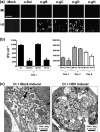Interaction of herpes simplex virus type 2 (HSV-2) glycoprotein D with the host cell surface is sufficient to induce Chlamydia trachomatis persistence
- PMID: 20110302
- PMCID: PMC2889450
- DOI: 10.1099/mic.0.036566-0
Interaction of herpes simplex virus type 2 (HSV-2) glycoprotein D with the host cell surface is sufficient to induce Chlamydia trachomatis persistence
Abstract
When presented with certain unfavourable environmental conditions, Chlamydia trachomatis reticulate bodies (RBs) enter into a viable, yet non-cultivable state called persistence. Previously, we established an in vitro C. trachomatis and herpes simplex virus type 2 (HSV-2) co-infection model. These data indicate that (i) viral co-infection stimulates chlamydial persistence, (ii) productive HSV replication is not required for persistence induction, and (iii) HSV-induced persistence is not mediated by any currently characterized anti-chlamydial pathway or persistence inducer. In this study we demonstrated that chlamydial infectivity, though initially suppressed, recovered within 44 h of co-infection with UV-inactivated HSV-2, demonstrating that HSV-induced persistence is reversible. Co-incubation of chemically fixed, HSV-2-infected inducer cells with viable, C. trachomatis-infected responder cells both suppressed production of infectious chlamydial progeny and stimulated formation of swollen, aberrantly shaped RBs. In addition, pre-incubation of viral particles with viral glycoprotein D (gD)-specific neutralizing antibody prevented co-infection-induced persistence. Finally, exposure of C. trachomatis-infected cells to a soluble, recombinant HSV-2 gD : Fc fusion protein decreased production of infectious EBs to a degree similar to that observed in co-infected cultures. Thus, we conclude that interaction of HSV gD with the host cell surface is sufficient to trigger a novel host anti-chlamydial response that restricts chlamydial development.
Figures




References
-
- Abdelrahman, Y. M. & Belland, R. J. (2005). The chlamydial developmental cycle. FEMS Microbiol Rev 29, 949–959. - PubMed
-
- Amici, C., Rossi, A., Costanzo, A., Ciafre, S., Marinari, B., Balsamo, M., Levrero, M. & Santoro, M. G. (2006). Herpes simplex virus disrupts NF-κB regulation by blocking its recruitment on the IκBα promoter and directing the factor on viral genes. J Biol Chem 281, 7110–7117. - PubMed
-
- Bragina, E. Y., Gomberg, M. A. & Dmitriev, G. A. (2001). Electron microscopic evidence of persistent chlamydial infection following treatment. J Eur Acad Dermatol Venereol 15, 405–409. - PubMed
Publication types
MeSH terms
Substances
Grants and funding
LinkOut - more resources
Full Text Sources

